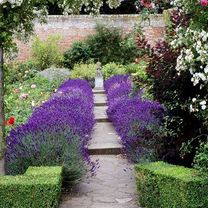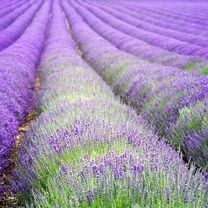Cooking with lavender was not something my grandmother ever did. However, open any wardrobe and you’d find a handmade lavender bag fighting the smell of mothballs. Whilst mothballs have thankfully been left in the past the lavender bag lives on. Perhaps now more often used beneath a pillow to aid sleep than to fight against bad odour.
Lavender is one of those wonderful plants that has a myriad of uses. It looks fabulous growing in the garden, feeds butterflies and bees, can withstand a drought but is also amazing once cut and dried.
 To preserve the essential oils held within the buds cut your lavender before it is fully open. Leave the stems long so they can be tied in bunches and then hung upside down, out of direct sunlight. You can leave the bunches hanging until you come to use them. Alternatively, strip the buds from the stems and keep them in an airtight jar in a cool cupboard.
To preserve the essential oils held within the buds cut your lavender before it is fully open. Leave the stems long so they can be tied in bunches and then hung upside down, out of direct sunlight. You can leave the bunches hanging until you come to use them. Alternatively, strip the buds from the stems and keep them in an airtight jar in a cool cupboard.
Lavender oil is one of the most popular of the essential oils as it has so many uses. A natural antiseptic and sedative it is also very effective in treating scalds and minor burns.
When cooking with lavender it doesn’t have to be dried. Both the leaves and the flowers can be used fresh. The flavour of dried lavender is however stronger and so possibly better. A word of caution – avoid lavender is pregnant or breastfeeding.
Lemonade
Follow any traditional lemonade recipe, mixing dried lavender with the sugar before adding the water.
Jelly
When making apple jelly include 6 tbsp of lavender buds for every 1.8kg of apples. The result will be a lovely fragrant jelly.
Sugar
Whizz lavender in a food processor until fine and then mix with caster sugar. This can then be used to flavour cakes and biscuits.
Chicken
Red wine, oranges, thyme and lavender work well in a sauce to serve with chicken or included in a casserole.
Goat’s Cheese & Brie
Sprinkle a little lavender on the cheese before wrapping and baking. Serve with warm crusty bread.
Biscuits
Make plain butter biscuits but add finely chopped lavender leaves or flowers with the butter.
Cordial
Stir 100g sugar over a gentle heat with 500ml of water until it has dissolved. Then add 1 tbsp of lavender flowers, cover and boil. Take it off the heat and leave to infuse for about an hour. Strain the liquid and then bring it back to the boil and stir until thickened. Allow to cool and then pour into sterilised bottles.
These are just a few of the many ways in which lavender can be enjoyed in the kitchen. As well as in the garden!
Last Updated on October 27, 2025 by Suttons Horticultural Team




Love the sound of lavender infused vodka. If you’d like to share any of those recipes then please do!
Really very good news!!! this information is really worth looking everyone. Great tips. I is going to be sharing this with all my friends! Thanks for sharing useful information.
http://rexgarden.com/
There’s some lovely recipes there, thanks 🙂 I’m still inventing cocktail recipes for some lavender-infused vodka I made a few years ago. It’s surprisingly nice with rhubarb: http://thegardeners.kitchen/2016/07/rhubarb-shrub/!